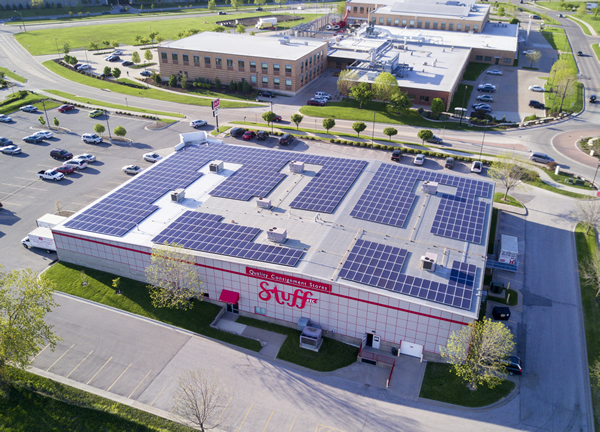
Iowa’s first large commercial solar-plus-storage project by Ideal Energy Solar
You never change things by fighting existing reality. To change something, build a new model that makes the existing model obsolete.–Buckminster Fuller
Today HOMER Energy announces a new model – HOMER Grid, a robust, powerful tool for optimizing the value of behind-the-meter, distributed generation systems, especially when demand charges and energy arbitrage matter. HOMER Grid is not a replacement for our flagship product, HOMER Pro, but an alternative to it. In this article I explain some of the important differences between the two products, and why we created HOMER Grid.
A story often told in the world of modernizing power compares the experiences of Alexander Graham Bell and Thomas Edison traveling through time to the present, where they can view the current state of their inventions. Bell sees essentially nothing that he recognizes. Communication has taken a quantum leap in a short period of time. Edison, on the other hand, sees that his network of poles and wires has expanded to serve a much larger population, and although the power plants are larger and cleaner, it is quite recognizable as the same technology.
An Energy Revolution is Coming – What Will it Look Like?
Anyone paying any attention at all knows that we are in the process of an energy revolution, but almost no one agrees about what the future of energy will look like exactly. It is certain, however, that renewables and storage will continue to grow in importance, and there will be more decentralization, both in grid-connected systems with high reliability and in mini-grid and microgrid systems that provide primary power.
HOMER: A Game Changer for Microgrids
For over two decades, the HOMER software has been instrumental in helping stakeholders understand the complexities and tradeoffs of designing cost-effective, reliable microgrids and hybrid-energy systems. Since taking over the development and distribution of HOMER from its original home at the National Renewable Energy Laboratory (NREL) in 2009, HOMER Energy has focused on listening to the marketplace and enhancing HOMER to continue to meet the needs of new technologies and approaches. We released HOMER Pro in November of 2014, and we are now on the 12th incarnation of this product, which has become the true global standard for techno-economic optimization of hybrid power systems.
The roots of HOMER were in electrification. The original version came out of NREL’s “Village Power” program. Dr. Peter Lilienthal applied the principles of decision analysis to create a program to help determine the best ways in which to add renewables and storage to avoid running a generator – making clear the tradeoffs between making capital investments in renewables and storage, as opposed to operating expenses in fuel and maintenance.
We have long maintained that the lessons learned in the world of electrification could help jumpstart changes in the grid-connected world. As both solar photovoltaics and storage have dropped in price, the case for using them in grid-connected environments has escalated. Although these technologies still represent a tiny minority of load, utilities are paying attention. One scenario is that customers may defect entirely away from the grid, or they may radically shift usage patterns so that the utility becomes a backup. This is an extremely difficult situation for the utilities, who must both meet the load and maintain financial solvency. It is also a difficult situation for the customers, who are trying to navigate a changing tariff, incentive, and policy landscape, while managing a significant cost of doing business.
Demand Charges Make Up 25% of C&I Utility Bills
One of the ways in which utilities manage has been in the form of Demand Charges, which now make up about 25% of utility sales to commercial and industrial customers (Assessing Demand Charge Savings from Solar+Storage and Other Hybrid Systems, https://microgridnews.com/assessing-demand-charge-savings-from-solarstorage-and-other-hybrid-systems/). Demand charges are often based on the single highest 15-minute period of energy in a month. Some utilities apply “ratchet clauses,” which can use that single 15-minute period to set rates for an entire year. Imagine driving your car and getting charged more for gas for a year because of that one time you had to pass someone quickly in an emergency.
Enter HOMER Grid
Optimizing behind-the-meter systems to reduce demand charges is a very different problem than HOMER Pro’s approach to optimizing to the lowest cost of energy in each time step of a year. And yet, we knew that applying HOMER Pro’s underlying technology to the problem could help. Enter HOMER Grid, our newest software offering (https://homerenergy.com/trygrid).
The decision to create this new tool for grid-connected systems where demand charges, incentives, and energy arbitrage were of interest was not taken lightly by us, a fairly small company supporting a global user base from one office in Boulder, Colorado. HOMER Grid was created because we know that this tool is necessary in this growing and important market. The market needs a new model, and we wanted to support it.
The Core of HOMER Grid
HOMER Grid is truly a new approach, not simply branding the same thing with some minor changes. HOMER Grid and HOMER Pro share many core elements, however. Most importantly, both models combine robust economics with robust engineering and design elements. The HOMER Engine is three nested processes – power system simulation, optimization, and sensitivity analysis. In early 2016 we introduced a proprietary optimization algorithm – the HOMER Optimizer™. HOMER Grid uses both of these proven and trusted systems. Ditto for detailed simulation reports and information, ability to synthesize loads, OpenEI load database, large library of components, access to online resource and temperature databases, and much more. Both programs are comparing all possible combinations of power and storage options to determine which combination has the lowest cost of energy for the project lifespan.
System components in HOMER Grid include solar, storage, generators, and combined heat and power, which allows recovered generator waste heat to serve a thermal load. [Combined heat and power is an add-on module that is included at no cost with all licenses purchased through August 2018. After that CHP will be an add-on.]
What’s New in HOMER Grid
The most important difference between HOMER Grid and HOMER Pro is how they manage dispatch – the decision about how to meet the load in each timestep. In HOMER Pro, the goal is to fully meet the load in each time step with the lowest possible cost option. With HOMER Grid, the problem is different – how do you minimize demand charges by using storage (or generators or renewable resources) to keep your usage of grid power more stable, and less subject to being impacted by spikes? In some cases it may make more sense to use the solar panels to charge batteries than to directly meet a load or sell back to the grid, so the batteries are ready when needed. To account for these scenarios, we created a proprietary algorithm that looks ahead 48 hours for certain processes and up to one month for others.
Commercial and industrial tariff structures are complex, and it is essential to have tariffs correct in order to model accurately. HOMER Grid connects directly to the Genability tariff database, which currently covers about 95% of commercial and industrial US tariffs, as well as significant parts of Canada, Mexico, and Australia. If a tariff is available through Genability, it can be loaded directly into HOMER Grid. If not, there is an external tool that lets a user build a tariff, or we can do it for them. Incentives are another important aspect to the economics of behind-the-meter system. HOMER Grid includes 14 incentive templates that allow a user to very specifically define incentives.
What’s Coming in HOMER Grid
HOMER Grid is at version 1.1, and we are already planning significant improvements for versions 1.2 and 1.3, due out later in 2018. We have identified the need for a better tariff builder, and in the short-term we have created an external tool that can build importable tariffs. Other potential additions include integrations with Helioscope and PVSyst (popular PV design software already integrated with HOMER Pro), library controls, custom components, wind, biomass, multi-year tariffs, demand response, and much more.
Our approach to improving products is to listen to customer feedback, so we hope you will give HOMER Grid a try and let us know how it works for you. Now is the time to help us define the energy revolution.


I already have a license for Homer Pro; does this mean I have to by another licence for Homer Grid?
Hi Henerica,
We are answering you via email. Thanks for contacting us!
Hi Henerica – If you require the HOMER Grid dispatch strategy to save demand charges, then we recommend that you get a HOMER Grid license. It is a separate product, with a different modeling goal. If HOMER Grid sounds like it might be of interest, I recommend that you try the free trial to learn more about it.
We are offering HOMER Grid at a very deep discount (50%) through the end of August. We are also allowing our users who are a better fit for HOMER Grid than HOMER Pro to switch their licenses.
What types of systems do you model?